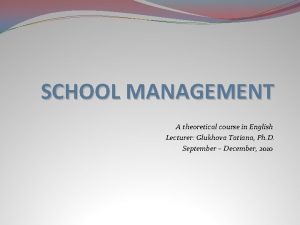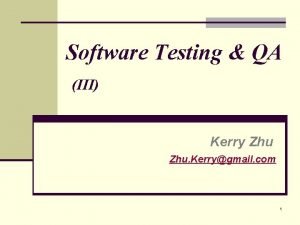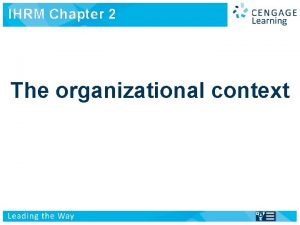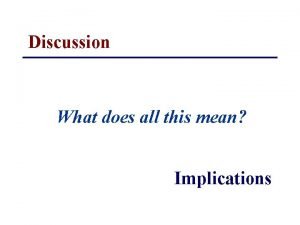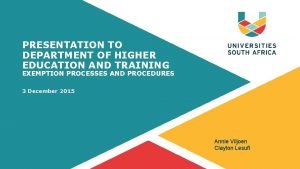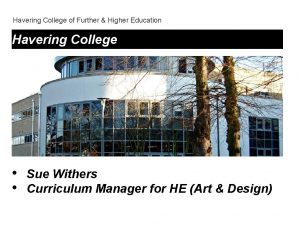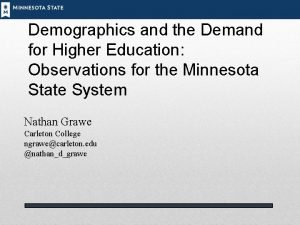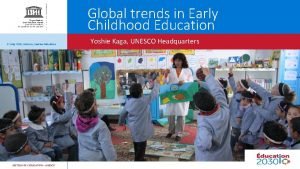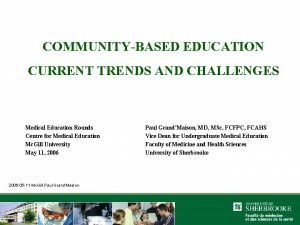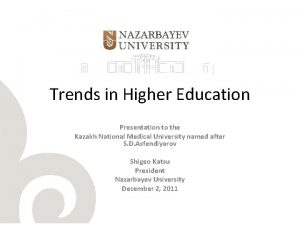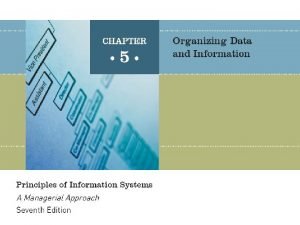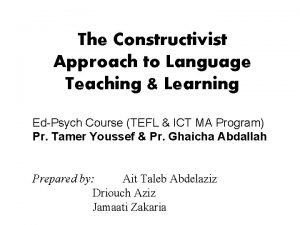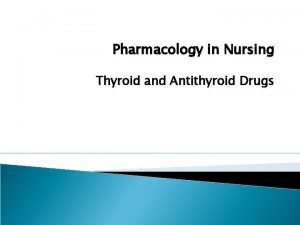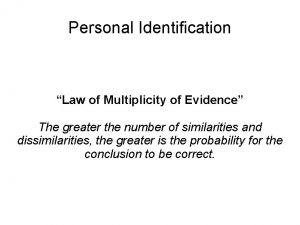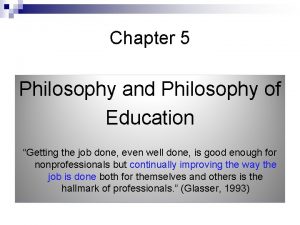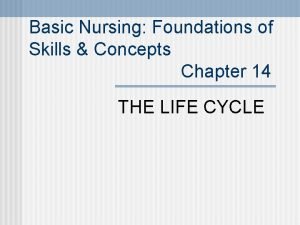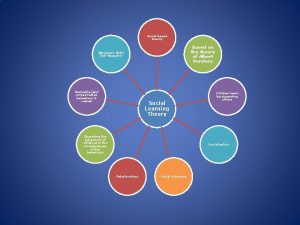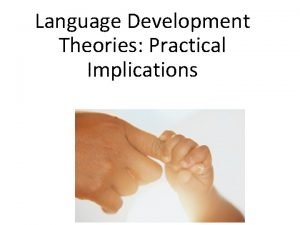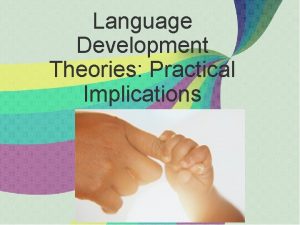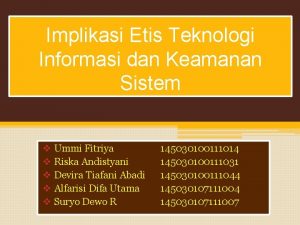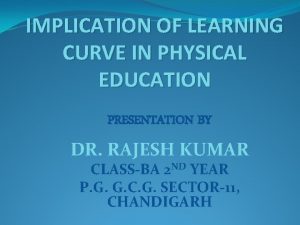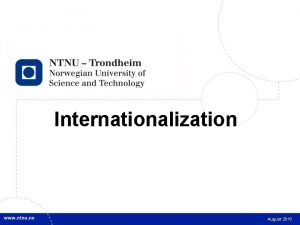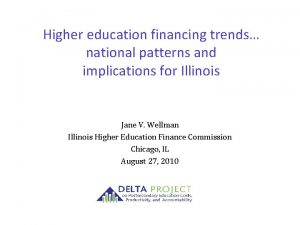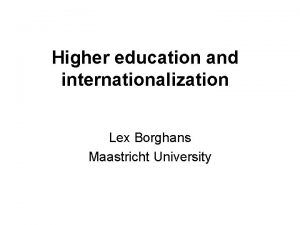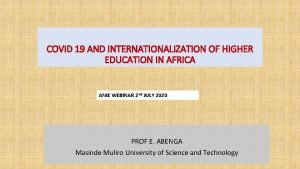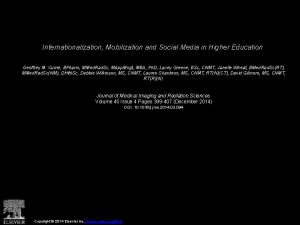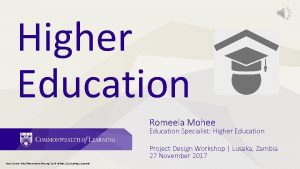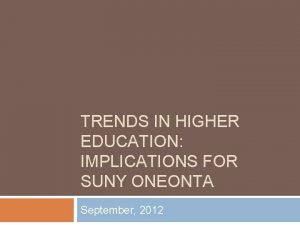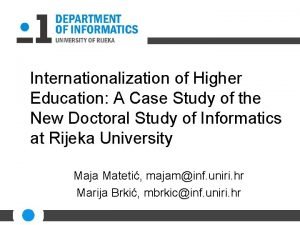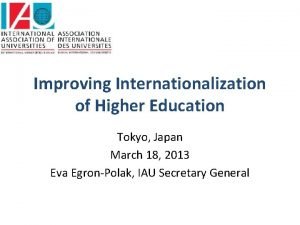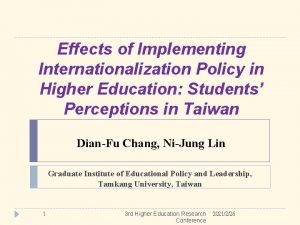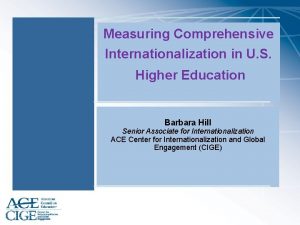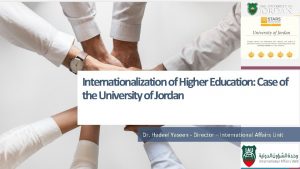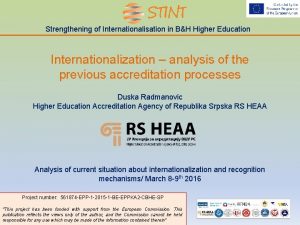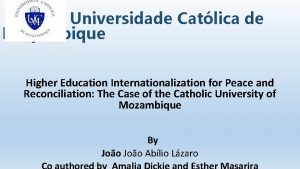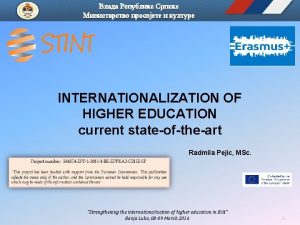TRENDS IN INTERNATIONALIZATION OF HIGHER EDUCATION AND IMPLICATIONS































- Slides: 31

TRENDS IN INTERNATIONALIZATION OF HIGHER EDUCATION AND IMPLICATIONS FOR QUALITY ASSURANCE WORK Professor Hans de Wit Director Center for International Higher Education NEASC, Boston, December 7, 2016

BOSTON COLLEGE CENTER FOR INTERNATIONAL HIGHER EDUCATION (CIHE), 1995 - Philip G. Altbach Founding Director Hans de Wit Director NEASC, Boston, December 7, 2016 2

BOSTON COLLEGE CENTER FOR INTERNATIONAL HIGHER EDUCATION (CIHE) www. bc. edu/cihe NEASC, Boston, December 7, 2016 3

§ A relatively new but broad and varied phenomenon § Driven by a dynamic combination of political, economic, socio-cultural and academic rationales and stakeholders § Impact on regions, countries and institutions according to particular context § No single model that fits all NEASC, Boston, December 7, 2016 4

1. Growing importance of internationalization at all levels 2. Increase in institutional strategies 3. Challenges of funding everywhere 4. Trend towards increased privatization through revenue generation 5. Competitive pressures of globalization, global rankings 6 Evident shift from (only) co-operation to (more) competition 7 Emerging regionalization, with Europe often a model 8 Numbers rising everywhere, with challenge of quantity versus quality NEASC, Boston, December 7, 2016 5

MISCONCEPTIONS ABOUT INTERNATIONALIZATION § Quantity should drive the agenda: more international students, more study abroad more co-publications, more courses in English § Universities are by nature international § Internationalization is a goal in itself NEASC, Boston, December 7, 2016 6

“NOT ONLY IS INTERNATIONALIZATION A MEANS RATHER THAN AN END, BUT THE ENDS MAY VARY FROM INSTITUTION TO INSTITUTION AND THE PARTICULAR APPROACH TO INTERNATIONALIZATION CHOSEN IS DEPENDENT ON THE ENDS BEING PURSUED. ”H(UDZIK, 2011) § We consider internationalisation too much as a goal in itself instead of as a means to an end. § Internationalisation is not more and less than a way to enhance the quality of education and research and their service to society. NEASC, Boston, December 7, 2016 7

INTERNATIONALIZATION POLICIES AND STRATEGIES § The Why, based on Internal and External Context analysis § The What § The How § And the Outcomes/Impact (What will be the impact of the strategy in 5 -10 years time on the quality of education and research? ) NEASC, Boston, December 7, 2016 8

TO ANSWER THE WHY QUESTION, CONTEXT ANALYSIS IS ESSENTIAL § Context is both external: global, regional, national and local § Context is also internal: by stakeholders § Context analysis is essential for both strategy development and assessment of strategies NEASC, Boston, December 7, 2016 9

§ MOBILITY: students, academics, administrators, programs, projects, institutions § PARTNERSHIPS: bilateral, multilateral, strategic § CURRICULUM: knowledge, skills and attitudes NEASC, Boston, December 7, 2016 10

The What: Two components • Internationalization Abroad • Internationalization at Home • Student Degree Mobility • Campus internationalization • Student Credit Mobility • Internationalization of the Curriculum • Student short term Mobility • Teaching and Learning • Staff Mobility • Joint Programs • Program mobility • Intercultural and international competences and learning outcomes NEASC, Boston, December 7, 2016

§ § Mobility Short and/or long term economic gain Talent recruitment International positioning § Incorporate approaches into more comprehensive strategies § Focus on internationalization of the curriculum and learning outcomes to enhance quality of education and research NEASC, Boston, December 7, 2016 12

Internationalization at Home, including Internationalization of the Curriculum, and Global citizenship Comprehensive Internationalization NEASC, Boston, December 7, 2016 13

§ “Internationalization at Home is the purposeful integration of international and intercultural dimensions into the formal and informal curriculum for all students within domestic learning environments. ” (Beelen and Jones, 2015) NEASC, Boston, December 7, 2016 14

§ “Internationalization of the curriculum is the process of incorporating international, intercultural and global dimensions into the content of the curriculum as well as the learning outcomes, assessment tasks, teaching methods and support services of a program of study. ” (Leask, 2015) NEASC, Boston, December 7, 2016 15

Two components: the social and professional are seen as key aspects of living and working in a global society Although global citizenship is a highly contested and multifaceted term, three key dimensions seem to be commonly accepted: global competence, social responsibility, , and civic engagement (Morais and Ogden 2011) NEASC, Boston, December 7, 2016 16

COMPREHENSIVE INTERNATIONALIZATION § A Commitment and Action to Infuse International, Global and Comparative Content and Perspective throughout the Teaching, Research and Service Missions of Higher Education § It shapes Institutional Ethos and Values and touches the Entire Higher Education Enterprise § It not only impacts all of Campus Life, but the Institution’s External Frameworks of Reference, Partnerships and Relationships. (Hudzik, 2011) NEASC, Boston, December 7, 2016 17

MEANING § The process of integrating an international, intercultural or global dimension into the purpose, functions and delivery of postsecondary education. § (Jane Knight) NEASC, Boston, December 7, 2016 18

A REVISED DEFINITION OF INTERNATIONALIZATION OF HIGHER EDUCATION Reflects increased awareness that § Io. HE must become more inclusive and less elitist § Mobility must become an integral part of the internationalized curriculum that ensures internationalisation for all Re-emphasises that § Internationalization is not a goal in itself, but a means to enhance quality § Should not focus solely on economic rationales NEASC, Boston, December 7, 2016 19

§ “The intentional process of integrating an international, intercultural or global dimension into the purpose, functions and delivery of postsecondary education, in order to enhance the quality of education and research for all students and staff and to make a meaningful contribution to society” § (de Wit et al, 2015, European Parliament Study) NEASC, Boston, December 7, 2016 20

KEY BARRIERS § Lack of funding, increased dependence on short-term external funding sources, over-focus on revenue generation, bureaucratic obstacles, disharmony of HE funding models, outsourcing to commercial entities § Increasing numbers of unethical practices, fraud, corruption by different stakeholders § Insufficient foreign language learning provision, dominance of English as language for education and research § Over-dominant focus on mobility, accessible only to small elite, not integrated into curriculum/teaching and learning, lack of engagement and reward of faculty and staff § Lack of integration of institutional, national and supranational policies NEASC, Boston, December 7, 2016 21

THE HOW: WHAT ARE KEY ENABLERS § Technological opportunities for virtual exchange and blended learning (enhanced international student interactivity) § Further development of joint and double degrees § Better mutual recognition of credits and degrees § Enhancement of qualitative indicators for quality assurance and classification systems § Greater commitment to equal partnerships § Stronger fostering of public-private initiatives § More alignment between education and research policies § More alignment with other education levels (primary, secondary, vocational, adult) NEASC, Boston, December 7, 2016 22

THE IMPACT: WHERE IS THIS NEW INTERNATIONALISATION GOING? PERCEIVED DESIRABLE OUTCOMES § A higher education system capable of producing global citizens and professionals § Respectful and appreciative of other cultures § Able to contribute to the development of knowledge economies and socially inclusive societies. § Better positioned to address global issues § To compete and cooperate, with the rest of the world, including the emerging regions NEASC, Boston, December 7, 2016 23

PERCEPTIONS AND PRACTICES § Internationalization has become a mainstream point of focus and reference in the Higher Education Sector § Big Words are used to make this clear: Soft Power, Reputation, Internationalization of the Curriculum, Global Citizenship, Sustainable Development Goals, Comprehensive internationalization § The Practice is still more on: Income Generation, Recruitment of International Students and Staff, Study Abroad and Teaching and Research in English § And Rankings measure only these last ones NEASC, Boston, December 7, 2016 24

RANKINGS’ APPROACH TO INTERNATIONALIZATION § Focus is on outputs, not on outcomes § Limited number of outputs: international students, international staff, internationally co-authored publications, study abroad (U-Multirank only) § There is no common agreement on the definition of these used indicators § And these indicators do not reflect the broader scope and outcomes/impact of internationalization NEASC, Boston, December 7, 2016 25

QUALITY AND RANKINGS § It is important to state that rankings like accreditations, must be the outcome of quality not direct the way quality assurance processes should be done. § National, Regional and International Rankings measure their concept and indicators of quality not your quality § There are too many universities aspiring to be high in the rankings than there are places in the top. § And it is easier to stay on the top than to get there. § So be realistic and stick to your own mission and qualitative indicators, do not let yourself driven by those of the rankers and be critical about those of accreditors. NEASC, Boston, December 7, 2016 26

IMPLICATIONS § Look at your quality assurance process in the context and enhancement of your own mission and vision, and your own students and staff § See internationalization as a means to enhance the quality of your institution, its programs, students and staff § This implies more emphasis on curriculum, teaching and learning as well as service learning than on unrealistic targets of big mobility schemes. 27 NEASC, Boston, December 7, 2016

OTHER WAYS OF MEASURING IMPACT § Other instruments like quality assurance and accreditation have a positive impact on internationalization. § And internationalization can influence in a more qualitative way those processes. § Increasingly accreditation includes internationalization in its assessment, although even there the shift from output to outcomes is still limited. § Processes like the ISAS of IAU (institutional quality assurance) and Ce. Quint of ECA (institutional and program, certified and related to accreditation) are relating input, output and outcomes in a qualitative way. NEASC, Boston, December 7, 2016 28

Standards and Criteria for Ce. Quint standards and indicators at Program level • • 1. Intended Internationalization: 1 a. Supported Goals 1 b. Verifiable Objectives 1 c. Impact on Education • • 3. Teaching and Learning: 3 a. Curriculum 3 b. Teaching Methods 3 c. Learning Environment • 2. International and Intercultural Learning: 2 a. Intended Learning Outcomes 2 b. Student Assessment 2 c. Graduate Achievement • • 4. Staff: 4 a. Composition 4 b. Experience 4 c. Services • • 5. Students: 5 a. Composition 5 b. Experience 5 c. Services • • • NEASC, Boston, December 7, 2016

Assessment • • Unsatisfactory Satisfactory Good Excellent • At least three standards have to be assessed as good or excellent and no standard as unsatisfactory to recevie the Certificate for Quality in Internationalisation at the program or institutional level NEASC, Boston, December 7, 2016

CONCLUDING OBSERVATIONS § Internationalization in higher education is on the rise and becomes increasingly more strategic § Mobility is still the key component in international education, in particular degree mobility of students § But in a comprehensive approach to internationalization abroad plus at home, integration, diversity, sustainability and ethics/values are key factors for quality. NEASC, Boston, December 7, 2016 31
 Internationalization of higher education in the philippines
Internationalization of higher education in the philippines Globalization vs internationalization
Globalization vs internationalization Internationalization testing checklist
Internationalization testing checklist The path to global status in ihrm
The path to global status in ihrm Balagtas
Balagtas Discussion and implications
Discussion and implications Department of higher education and training
Department of higher education and training Havering college of further and higher education
Havering college of further and higher education Efficiency and effectiveness in higher education
Efficiency and effectiveness in higher education Demographics and the demand for higher education
Demographics and the demand for higher education Trends in early childhood education
Trends in early childhood education Current trends in medical education
Current trends in medical education Trends in education
Trends in education Trends in immunology
Trends in immunology Database management approach
Database management approach Constructivism
Constructivism Implication table state minimization
Implication table state minimization Nursing implications for synthroid
Nursing implications for synthroid Law of multiplicity of evidence in identification
Law of multiplicity of evidence in identification Media have commercial implications
Media have commercial implications Marketing implications
Marketing implications Tautological implications in discrete mathematics
Tautological implications in discrete mathematics Proposition in math
Proposition in math Perennialism in education
Perennialism in education Consumer behavior cengage
Consumer behavior cengage Nursing implications
Nursing implications Albert bandura theory
Albert bandura theory Legal implications of social media
Legal implications of social media Implications of nativist theory
Implications of nativist theory Implications of nativist theory
Implications of nativist theory Security implications
Security implications Educational implications of learning curve
Educational implications of learning curve

